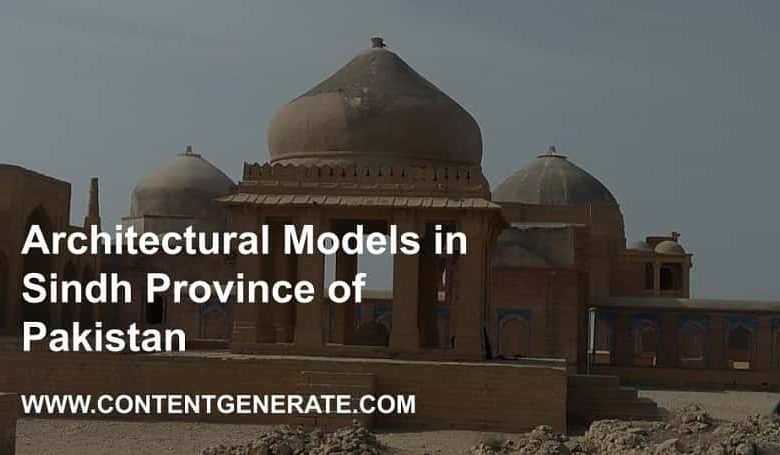Architectural Models in Sindh Province of Pakistan

Architectural models of the Sindh region of Pakistan can be classified into four main categories i.e. ancient architecture, Indo-Islamic architecture, Colonial architecture, post-independence architecture.
Each of the above architectural models of Sindh is discussed in detail below:
Contents
1. Ancient model of architecture
Archeologists consider Sindh to be one of the cradles of civilizations that emerged, rose to eminence, and then disappeared in the Indian subcontinent. Indus Valley Civilization got birth, developed, and declined some 2500 BCE in the Sindh province of present-day Pakistan. The Mohenjodaro near Larkana is the place the earliest settlers of the Indus Valley Civilization inhabited.
Main Features of Architecture of Indus Valley Civilization
The remains of the Indus Valley Civilization at Mohenjodaro in Larkana Sindh carried the following salient features:
- It carried a planned layout with rectilinear buildings arranged on a grid plan.
- Most of the structures were built of fired and mortared brick.
- Some buildings were made of sun-dried mud-brick and wooden superstructures.
- The architectural sites were often built on a raised place or man-made hills.
- The people of Indus Valley erected strong walls surrounding the building of the city.
The layout of the city
The city was divided into two separate parts: the citadel and the lower town outside.
The citadel was a parallelogram of two to three hundred yards east-west and four to five hundred yards north to south. The citadel contained official buildings and acted as the last part of the defense.
Contrary to the citadel, the lower town contained lower-valued residential buildings of the common people. Unlike the buildings in the citadel, this part of the city was without a surrounding wall, thus exposing the residence to outside attacks.
2. Indo-Islamic Model of Architecture
With impressive exquisiteness and aestheticism, Sindh shelters magnificent and imposing ancient and historical architectural monuments, e.g. Sufi tombs, forts, mosques, imperial palaces, etc. This particular architectural style is one of the architectural models of Sindh.
During the Mughal Empire, different Muslim dynasties ruled India in different regions and at different times i.e. Kalhoros, Talpurs, etc. These dynasties were constructed with such imposing and beautiful buildings and non-building structures which more or less represented Mughal patronized Indo-Islamic architecture.
Kalhoro architecture
- The architecture developed by the Kalhoro rulers of Sindh is characterized by Mosques, tombs, forts, etc.
- The architectural aspects and patterns of Sindh during the Kahoro period were already in vogue in the rest part of the Indian subcontinent.
- Ceramics were used as brick and part of the building ornamentation i.e. Lily Arabesque was used in Mural ceramics in Jami Mosque, Khudaabad.
- The monuments especially the tombs of Kalhoro rulers carried wall paintings as part of the decoration.
- Kashi or glazed tiles carrying geometric and floral designs were extensively used as part of building decoration.
Talpur architecture
Talpur dynasty replaced the Kalhoro dynasty after defeating them in a battle in Sindh. Commonly known as Amirs of Sindh, Talpur were very rich and wealthy rulers.
- Like those of Kalhoros, the Talpurs also loved constructing architectural monuments with royal grace. The most famous architectural practice they promoted was the tomb building. Some of these tomb structures have attracted a huge number of visitors both from within and outside Pakistan.
- The most famous tomb site developed during the Talpur period is the Tombs Complex located in Hiraabad, Hyderabad. The complex contains large mausoleums of the Talpur rulers, their wives, and infants with several marked and unmarked graves outside it.
- The graves were made of marble and carry inscriptions of Qurani verses on their surfaces.
- Moreover, the tombs in the complex are either square or rectangular in shape that resembled the architectural pattern adapted in the tombs of the predecessors, the Kalhoros.
- Like many of the Kalhoro rulers, most of the Talpur rulers also designed and prepared their own burial sites while alive.
3. Colonial/Indo-Saracenic architecture
The establishment of the British Empire greatly influenced the architecture and culture of India and led to a fusion of architectural styles and techniques. This new syncretic architectural style is known as the Indo-Saracenic architectural style.
Features of Indo-Saracenic Architecture
- It’s an amalgam and fusion of European and Indo-Islamic elements.
- European styles such as the Baroque, Gothic, and Neoclassical became prevalent.
- The buildings were elaborate projecting the power the British enjoyed and exercised in India.
Examples of Indo-Saracenic architecture
Some of the buildings representing Indo-Saracenic architecture in Karachi include Frere Hall, Empress Market, Saint Patrick’s Cathedral (Gothic architecture), Saint Andrews Church, Karachi (Gothic architecture), etc.



